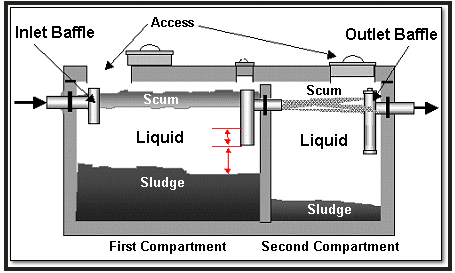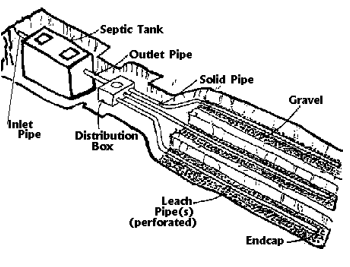Individual Sewage Disposal System - Community
Residential Individual Sewage Disposal Systems
A septic tank system will serve a home satisfactorily only if the system is properly designed, installed, and maintained. A neglected or abused system may result in liquid waste overflow to the ground surface or stopped-up plumbing in the home. Overflows not only create offensive odors, but are also health hazards. Sewage may contain infectious disease organisms and are prime breeding places for some kinds of mosquitoes and other insects.
The Septic Process
The septic tank is a water tight structure in which organic solids are decomposed by natural bacterial processes. Sewage flow is slowed within the tank to allow solids to settle to the bottom (sludge) and to allow grease and floatable solids to rise to the surface and accumulate (scum). Bacteria biologically converts some of the solids to liquid. Liquid from the middle layer of the tank passes out of the tank to a subsurface leach field for absorption into the soil. Build-up of solids (sludge and scum) within the tank will eventually result in an overflow of solid material into the soil absorption area. This overflow will cause clogging in the absorption field area and may result in system failure (ponding sewage and/or backed-up plumbing).
Drainfields
The drainfield is where liquid from the septic tank flows through pipes in your yard for final treatment by organisms naturally occurring in the soil. Don't park cars and trucks on the drainfield or septic tank. Also, don't install driveways, patios, carports, decks, storage sheds, sports courts, landscaping plastic, and/or allow animals to graze. These activities pack soil and may lead to pipes breaking.
Your yard should also have a "reserve area" which is where your replacement drainfield will be located if your drainfield fails.
The Do's of Septic Tank Maintenance
- Use water sparingly. Do only full loads of wash at off-peak times and try to limit the number of loads per day if possible.
- Limit use of garbage disposals. Ground up foods are hard on septic systems since they are not digested by the human body first.
- Remove solids from the septic tank by periodic pumping. Pumping frequency will depend on the size of the tank and the number of persons using the system. A 1,000 gallon system serving a 4-person family will typically require cleaning every 2 to 3 years.
- Fix all plumbing leaks as soon as possible. A leaking faucet or toilet can overload the septic system.
- To facilitate cleaning and maintenance, the homeowner should have a diagram showing the locations of all septic system components with relation to the house. The diagram should be passed to subsequent owners if the house is sold.
The Don'ts of Septic Tank Maintenance
- Do not plant deep rooted plants (trees, shrubs) within 10 feet of the septic system.
- Do not pour kitchen grease into drains.
- Do not flush cigarette butts, sanitary napkins, and other inorganic materials down the toilet.
- Do not drive over the septic system. Most septic tanks and sewer piping are not designed to support the weight of an automobile. In addition, compacting the soil over an absorption field will increase the likelihood of premature failure.
- Do not ignore warning signs of problems. Contact a licensed septic system repair company at the first sign of trouble (found in the yellow pages under "septic").
Warning Signs of Septic System Failure
- Sluggish drains or plumbing back-ups in the home.
- Outdoor odors.
- Gurgling sounds in pipes or drains.
- Mushy ground around the septic system.


